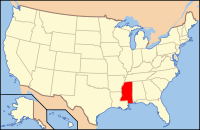Oktibbeha County, Mississippi
| Oktibbeha County, Mississippi | |
|---|---|
 Location in the U.S. state of Mississippi |
|
 Mississippi's location in the U.S. |
|
| Founded | 1833 |
| Seat | Starkville |
| Largest city | Starkville |
| Area | |
| • Total | 462 sq mi (1,197 km2) |
| • Land | 458 sq mi (1,186 km2) |
| • Water | 3.7 sq mi (10 km2), 0.8% |
| Population | |
| • (2010) | 47,671 |
| • Density | 104/sq mi (40/km²) |
| Congressional districts | 1st, 3rd |
| Time zone | Central: UTC-6/-5 |
| Website | www |
Oktibbeha County is a county located in the U.S. state of Mississippi. As of the 2010 census, the population was 47,671. Its county seat is Starkville.
The Starkville, MS Micropolitan Statistical Area includes all of Oktibbeha County. Oktibbeha County, along with Lowndes and Clay counties, compromise the Golden Triangle region of the state. Oktibbeha County is home of Mississippi State University, Mississippi's land grant institution and largest university.
The name Oktibbeha is a Native American word meaning either "bloody water" (because of a battle fought on the banks) or possibly "icy creek". Indian artifacts more than 2000 years old have been found near ancient earthwork mounds just east of Starkville. These have been used to date the construction of the mounds to the Woodland period, ending about 1000 A.D. The Choctaw people, one of the Five Civilized Tribes of the Southeast, occupied extensive territory in this area for centuries prior to European encounter. The Indian Mound Campground nearby was named for the earthwork monuments. The area has been inhabited for over 2100 years. Artifacts in the form of clay pot fragments and artwork dating from that period have been found east of Starkville at the Herman Mound and Village site, a National Historic Register site that can be accessed from the Indian Mound Campground. Shortly before the American Revolutionary War period, the area was inhabited by the Choccuma (or Chakchiuma) tribe, who were annihilated about that time by a rare alliance between the Choctaw and Chickasaw at a settlement known as Lyon's Bluff. The modern early settlement of the area was started after the Choctaw inhabitants of Oktibbeha County surrendered their claims to land in the area in the Treaty of Dancing Rabbit Creek in 1830.
...
Wikipedia
